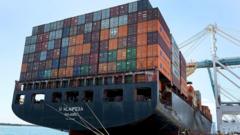The World Trade Organization (WTO) has issued a compelling forecast indicating a notable downturn in global trade for the current year, primarily attributing this decline to the tariffs imposed by US President Donald Trump. The organization has cautioned that "severe downside risks," which include reciprocal tariffs and entrenched political instability, may provoke an even more pronounced contraction in international goods trade. Specifically, the WTO highlighted that North America is poised to see trade shrink by over 10%.
Ngozi Ikonjo Iweala, the WTO's director general, expressed concern over the "decoupling" between the United States and China, labeling it a "phenomenon that is really worrying." The WTO had initially anticipated a global goods trade increase of 2.7% by 2025 but has revised this expectation to a 0.2% decrease.
Ralph Ossa, the WTO's chief economist, underscored the unforeseen repercussions of tariff policies, saying, "Tariffs are a policy lever with wide-ranging, and often unintended consequences." He noted that uncertainties surrounding trade policy could significantly dampen trade flows, leading to reduced exports and weakened economic performance.
Since the implementation of a baseline 10% tariff on nearly all foreign imports to the US on April 5, and with China facing an even heftier tariff of 145% on most goods, the US stock market has reacted unfavorably, with major indexes experiencing declines amidst persistent uncertainty.
Despite the predicted downturn primarily affecting trade with the United States, there are forecasts of growth in specific regions. The WTO predicts that Asia and Europe will continue to witness modest advancements in both exports and imports throughout the year, with other regions collectively contributing positively to world trade growth.
In a notable addition, the WTO's report includes, for the first time, projections regarding services trade, which pertains to the exchange of services between nations. This is commonplace in sectors like tourism and finance, where services are provided without tangible goods being shipped. The WTO anticipates that services trade will rise by 4% by 2025, albeit down approximately one percentage point from what had been expected previously.
The record of Trump's tariff initiatives has been tumultuous. Since his inauguration in January, the president's administration has oscillated between implementing and retracting tariffs, often in response to political pressure and market feedback. Following the enforcement of steep tariffs against around 60 trading partners, Trump announced a temporary 90-day freeze on most tariffs, sparing only China, as opposition mounted from various political factions and stakeholders.
As the tariffs continue to reshape trade dynamics, the broader impact is expected to be felt across global markets, with implications for consumer spending and economic stability in multiple countries, including the UK, where monetary policy officials have already voiced concerns about the potential effects of US tariffs on local consumers' purchasing power.





















